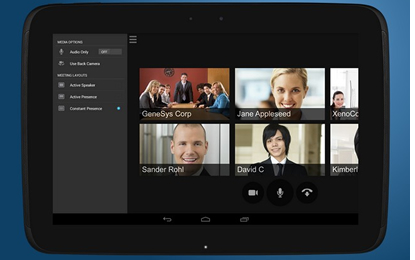Mobile video conferencing took another step forward recently with the announcement of a new joint venture between Blue Jeans and Tely Labs that allows for small and medium businesses to have a simpler, more affordable way to collaborate through the cloud.
 Priced at around $1,000 per year, the Blue Jeans for Tely cloud based mobile video conferencing service combines Blue Jeans’ cloud-based video service with Tely’s plug-and-play video endpoint. The service works on wide range of mobile devices, but is ideal for larger-screen tablets.
Priced at around $1,000 per year, the Blue Jeans for Tely cloud based mobile video conferencing service combines Blue Jeans’ cloud-based video service with Tely’s plug-and-play video endpoint. The service works on wide range of mobile devices, but is ideal for larger-screen tablets.
“Pairing a simple device with a cost-effective cloud service is exactly how small-and-medium-sized businesses will bring video conferencing into their meeting rooms,” said Andrew Davis, senior partner at Wainhouse Research, in a recent story in Telepresence Options, the website and magazine devoted to teleconferencing.
Tely Labs CEO and co-founder Sreekanth Ravi says that their small and medium business customers have been clamoring for a system that connects their laptops and mobile devices to company conference rooms.
BYOD: pros outweigh cons
 The demand for mobile video conferencing has been boosted in large part by another trend – the “bring your own device” to work trend. Many folks are shelling out big bucks for the latest and greatest tablets and smartphones. They don’t want these devices restricted solely to their personal lives and companies are seeing an opportunity to save on valuable hardware. Hence, more and more workplaces are encouraging their employee to bring in and use their devices.
The demand for mobile video conferencing has been boosted in large part by another trend – the “bring your own device” to work trend. Many folks are shelling out big bucks for the latest and greatest tablets and smartphones. They don’t want these devices restricted solely to their personal lives and companies are seeing an opportunity to save on valuable hardware. Hence, more and more workplaces are encouraging their employee to bring in and use their devices.
One major problem with BYOD is the fact that company IT departments are having a tough time trying to keep up with the security and interoperability demands of the arrangement. However, the tide of employees wanting to bring in their devices could be too strong to turn back.
Richard Absalom, an analyst at the media research company Ovum, recently told Tech Radar that BYOD is happening – whether companies are prepared or not. He suggests that small- and medium-sized businesses should simply embrace the trend and go from there. “Trying to stand in the path of consumerized mobility is likely to be a damaging and futile exercise,” he says.
In fact, a March 2013 from survey Wainhouse Research found 34 percent of respondents access video conferencing from a tablet, while another 33 percent said they do so from a smartphone. A September 2013 research report from Gartner Inc. concluded businesses will increasingly use mobile collaboration to empower workers, increase productivity and interact with customers over the next three to five years.
In addition to saving money on hardware, BYOD has several other positive attributes – including higher employee satisfaction and increased productivity. Workers will be happier because their devices allow for more flexibility in completing tasks and they will also be more productive working with their own, increasingly-familiar devices.
However, businesses should rightly be concerned about security. In addition to increased risk of virus exposure, BYOD also enables unscrupulous employees to quickly steal data to proprietary information.
“Security and the loss of devices with limited password protection is naturally a key concern,” notes Shaun Smith, technology practice director at Xceed Group.
There are also associated costs to consider – such as supplementing a company’s security infrastructure. Other costs might be associated with integrating the various devices and operating systems.
“For a company to decide if a BYOD strategy would work for them they need to ensure due diligence is conducted – simply evaluating the benefits versus risks,” Smith says.
Will big phones boost mobile video conferencing?
Proponents of both mobile video conferencing and BYOD should be applauding the recent unveiling of the larger-screened Google Nexus 6 and Apple iPhone 6 Plus – yet Dennis Collins, director of marketing at Intercall, recently wrote in his company’s blog that the use of the new devices for video conferencing is somewhat debatable.
“Larger phones may encourage greater use of FaceTime and other one-to-one video chat applications, but the displays simply remain too small to effectively manage multi-windowed conferences or webcasts,” Collins says. In addition to screen real estate concerns, the new [phone] screens are also too small for a proper user interface, he says. The reality of the small screen size can be compensated for by putting controls in a pull-down menu – but this just makes for a less intuitive experience, something that runs counter to the Apple ethos.
Collins predicts that tablets will continue to be the go-to device for mobile video conferencing, and all signs indicate that tablets will be getting larger. These larger screens will be much better at accommodating video conferencing solutions.
“Tablets are specifically designed to meet the instant-on, work anywhere environment of increasing numbers of workers and workplaces,” Collins says. “The iPhone 6 and 6 Plus will undoubtedly have a large influence on consumer smartphone usage, but in the mobile video conferencing realm, tablets are still king.”
Recent Related Stories:
Hangouts adds Google Voice; Viber adds mobile video calling (MobileVillage)
Survey shows generation gap on mobile & online security, privacy (MobileVillage)
Survey: Half of US workers use personal devices for work (MobileVillage)




